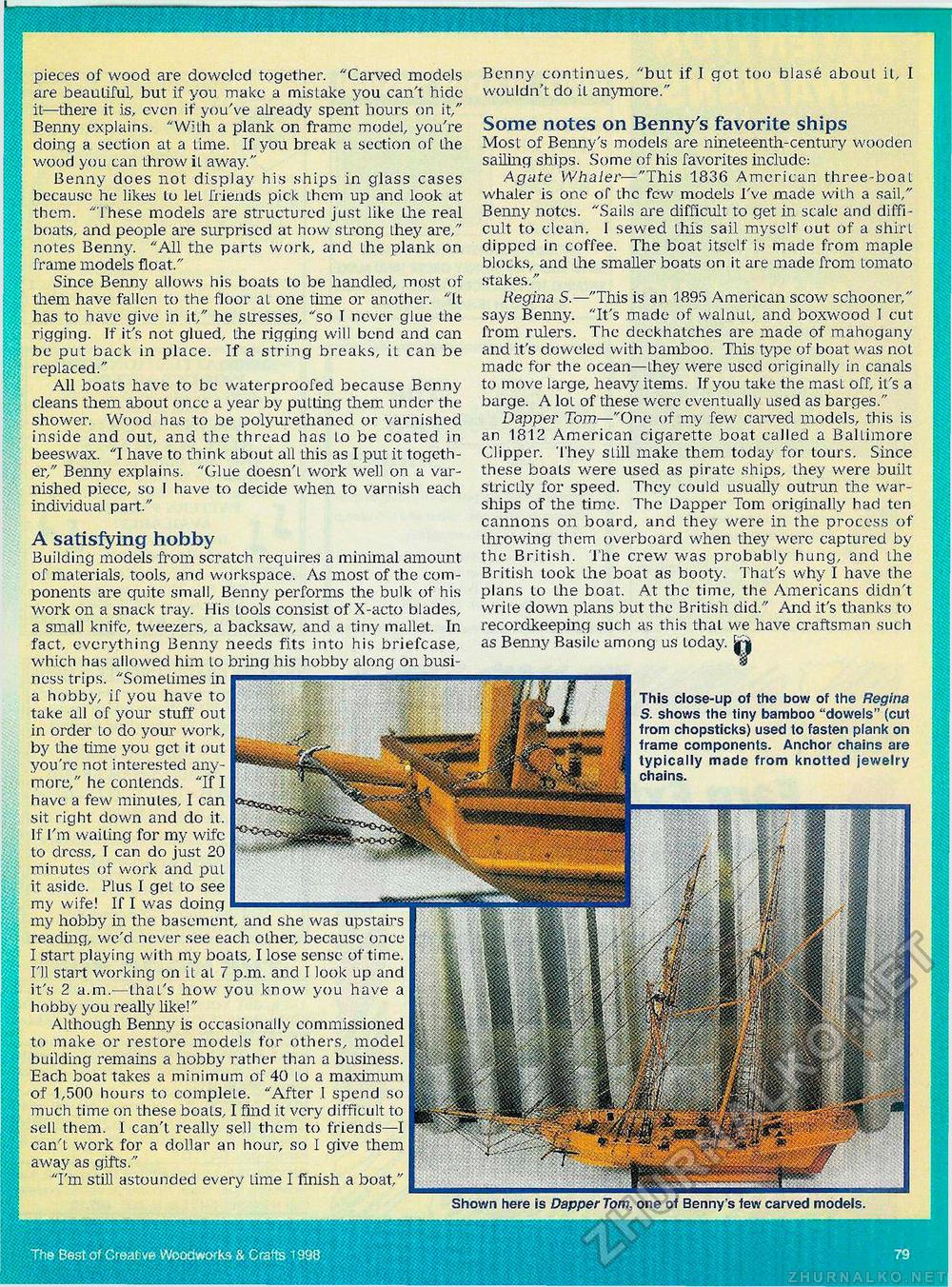Creative Woodworks & Crafts-059-1998-Fall, страница 79
Shown here is Dapper Tom, one of Benny's few carved models. pieces of wood are doweled together. "Carved models are beautiful but if you make a mistake you can't hide it—there it is, even if you've already spent hours on it/' Benny explains. "With a plank on frame model, you're doing a section at a time. If you break a section of the wood you can throw it away." Benny does not display his ships in glass cases because he likes lo let friends pick them up and look at them, " these models are structured just like the real boats, and people are surprised at how strong ihey are," notes Benny. "All the parts work, and the plank on frame models float." Since Benny allows his boats lo be handled, most of them have fallen to the floor at one time or another. "It has to have give in it," he stresses, "so I never glue the rigging. If it's not glued, Lhe rigging will bend and can be put back in place. If a string breaks, it can be replaced." All boats have to be waterproofed because Benny cleans them about once a year by puLling them under the shower. Wood has to be polyurethaned or varnished inside and out, and the thread has Lo be coated in beeswax. "I have to think about all this as I put it together," Benny explains. "Glue doesn'L work well on a varnished piece, so I have to decide when to varnish each individual part." A satisfying hobby Building models from scratch requires a minimal amount of maLerials, tools, and workspace. As most of the components are quite small, Benny performs the bulk of his work on a snack tray. His tools consist of X-acto blades, a small knife, tweezers, a backsaw, and a tiny mallet. In fact, everything Benny needs fits into his briefcase, which has allowed him to bring his hobby along on business trips. "Sometimes in a hobby, if you have to take all of your stuff out in order Lo do your work, by the time you get it out you're not interested anymore," he contends. "If I have a few minutes, I can sit right down and do it. If I'm waiting for my wife to dress, I can do just 20 minutes of work and put it aside. Plus 1 geL to see my wife! If I was doing my hobby in the basement, and she was upstairs reading, we'd never see each other, becausc once I start playing with my boats, I lose sense of time. I'll start working on iL aL 7 p.m. and T look up and it's 2 a.m.—thai's how you know you have a hobby you really like!" Although Benny is occasionally commissioned to make or restore models for others, model building remains a hobby rather than a business. Each boat takes a minimum of 40 Lo a maximum of 1,500 hours to complete. "After I spend so much time on these boats, I find it very difficult to sell them. I can't really sell them to friends—I can't work for a dollar an hour, so I give them away as gifts." "I'm still astounded every Lime I finish a boat," Benny continues, "but if I got too blase about it, I wouldn't do il anymore." Some notes on Benny's favorite ships Most of Benny's models are nineteenth-century wooden sailing ships. Some of his favorites include: Agate Whaler—"This 1836 American three-boat whaler is one of the few models I've made with a sail," Benny notes. "Sails are difficult to get in scale and difficult to clean. I sewed this sail myself out of a shirt dipped in coffee. The boat itself is made from maple blocks, and Lhe smaller boats on it are made from tomato stakes." Hegina S.—"This is an 1895 American scow schooner," says Benny. "It's made of walnuL, and boxwood 1 cut from rulers. The deckhatches are made of mahogany and it's doweled with bamboo. This type of boat was not made for the ocean—they were used originally in canals to move large, heavy items. If you take the mast off, it's a barge. A lot of these were eventually used as barges." Dapper Tom.—"One of my few carved models, this is an 1812 American cigarette boat called a BalLimore Clipper. They slill make them today for tours. Since these boats were used as pirate ships, they were built strictly for speed. They could usually outrun the warships of the time. The Dapper Tom originally had ten cannons on board, and they were in the process of throwing them overboard when they were captured by the British. The crew was probably hung, and the British look Lhe boat as booty. That's why I have the plans lo Lhe boat. At the time, the Americans didn't write down plans but the British did." And it's thanks to recordkeeping such as this thai we have craftsman such as Benny Basile among us today. jr| This close-up of the bow of the Regina S. shows the tiny bamboo "dowels" (cut from chopsticks) used to fasten plank on frame components. Anchor chains are typically made from knotted jewelry chains. |








